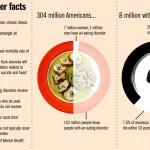The latest trending information cascade: Body Image and Eating Disorders
“Five to ten million people in the U.S have eating disorders. Ninety percent of people who have eating disorders are between the ages of 12 and 25. Over ½ of teenage girls and nearly 1/3 of teenage boys use unhealthy weight control behaviors such as skipping meals, fasting, smoking cigarettes, vomiting and taking laxatives. Americans spend over $40 billion on dieting and diet-related products each year. The average American woman is 5’4’’ tall and weighs 164 pounds. The average American model is 5’11’’ tall and weights 117 pounds” (www.dosomething.org). These are just a few of some very alarming and astounding facts regarding body image and eating disorders. While eating disorders have been around for a while, just recently they have been more publicized and discussed openly. Recently, many studies have looked at how people perceive themselves and their body image.
One study that was done looked at how women perceived themselves when comparing themselves with others. This study found that women when comparing themselves with smaller women considered themselves much fatter than in reality. Additionally, they found that if a woman was compared against someone larger then them then they would perceive themselves as much larger than they actually are. Overall the idea of comparison due to body image is often very swayed based on the context, which the comparisons are being made
With this understanding in mind, let’s think about it from an information cascade point of view. If women look at a model or someone that is considered to be “thin” then they will see something slightly skewed based on reality. With this skewed perception in mind then no wonder the thin ideal and eating disorders are way more common. Therefore, being thin is way more popular than being normal or overweight. If thinner women look happier, get the guys and have a more sexy appeal, then no wonder why people are choosing being thin or going to such extremes to be so abnormally thin. Just like in the in-class example: if one restaurant is more crowded people will naturally decide to go to that restaurant because of how they perceive it. This mindset can also be used with the latest trend of being thin. If everyone is constantly talking about dieting and always working out, then why wouldn’t you?
Body image and being thin can be looked at like a popular restaurant except this is a popular trend. More and more people are dieting and continually becoming thinner by the day. The more people are doing it the more people join in. Just like in class, the restaurant continues to get more crowded based on the number people inside of it but also talking about it. Therefore, dieting and body image continues to be in the forefront of people’s minds so it continues as a cascade. Furthermore, like our homework problem involving high or low signals, people in this body image cascade don’t always know the consequences or outcomes having an eating disorder or dieting to become super thin. Just like how the 10th person didn’t know what the signal of the third through ninth person was, not all of the 5-10 million people in the U.S with eating disorders understand the consequences of the previous people. Nor do they know that eating disorders rehab centers can cost up to 30,000 a month. Overall, many people are constantly getting caught in the body image cascade without truly understanding the real risks involved with it. So how are we going to stop this cascade and allow people to fully understand the risks and damage they are doing to their body?
References:
http://www.dosomething.org/tipsandtools/11-facts-about-eating-disorders
Choplin, J. M. (2010). I Am “Fatter” Than She Is: Language-Expressible Body-Size Comparisons Bias Judgments of Body Size. Journal of language and social psychology, 29(1), (pp. 55-74).
http://www.time.com/time/specials/2007/article/0,28804,1703763_1703764_1810730,00.html
http://scholar.lib.vt.edu/theses/available/etd-05112008-222537/unrestricted/KatePayneThesisMay30.pdf
Photos:
http://www.hygieneguard.com/facts-on-eating-disorders/
http://www.precisionnutrition.com/all-about-disordered-eating


